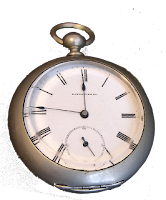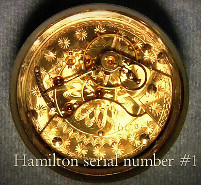Hamilton Watch Company, Lancaster, PA
Historians claim that the Hamilton Watch Company began in 1892, producing timepieces for the railroads. That date represents one of many reorganization of a watch manufacturer in Lancaster, PA. The year, 1892, is not the beginning of the organization. Not that 1892 doesn’t mark a significant milestone in the company’s history.
| Hamilton Watch Company |
Hamilton Watch Company is a product of corporate evolution
The company we know as Hamilton, began operations during the Long Depression of 1873-1879. It was called the Adams and Perry Watch Manufacturing Company formed in September 1874. Their headquarters? The Hamilton Watch Complex. Construction of the first building was completed in July 1875. The building, designed by Chicago-architect Clarence Luther Stiles in the Second Empire style, was three stories high and consisted of only the eastern tower, flanked on either side with a wing.
Adams and Perry Watch Company made excellent watches, but the company was under-capitalized.
  |
| Keystone Watch Company |
Local investors reorganized the operation and renamed it the Lancaster Watch Company in 1877. The investors underestimated the severity of the economic depression of the time and saw the endeavor struggle. Investors reorganized again in 1884. At this point, the name changed to the Keystone Standard Watch Company. It also failed and you can blame that on the aftermath of the Long Depression.
The people of Lancaster, PA had little motivation to put together another round of financing. That effort fell to the first CEO of the company – John Baushan – an influential lawyer and banker. He brought in 12 investors.
 |
| Lancaster Watch Company |
You may read that the name of the Company originated to credit Andrew Hamilton for donating the land on which the company built its factory and headquarters. It turns out that Abraham Bitner donated the land twenty years before. It helped to use the Hamilton name to influence members of the Hamilton society to raise capital.
That group of Lancaster elite families needed a hook to buy-in to the venture. Henry Cain was that hook. He was the guru of watch inventors. He and Charles Rood left Hampden watch company when they were bought out by John Dreuber. They started Aurora Watch Company In Springfield, Illinois, but like Hamilton, they were underfunded.
In 1892, they made a deal with Hamilton’s broad and brought Aurora and it’s equipment equipment to the former Keystone factory. Initially, they also brought in 35 employees: 20 of them came from Aurora, 15 from Waltham and none from Lancaster. Those 35 employees helped create the start-up. As the company began to sell watch, Cain tapped the local population of experience watchmakers and workers.
Mystery always surrounded Hamilton’s first watch. People wondered how Cain could manufacture a watch in such a short interval. The answer seems simple. He built Hampden Mod 3 movements, which Hamilton released as model 936. Of course, he made improvements.
A year after the formation of Hamilton, Hamilton delivered it first watch movements. Obviously, the didn’t start building watches designed from scratch.
Railroad inspectors and personnel favored Hamilton’s first watch, because of its reliability and precision. More than anything else, it fit the General Railroad Timepiece Standards. established by Webb C. Ball, the Chief Time Inspector of the Lakeshore and Michigan Southern Railway and eventual advocate of standards adopted nationally.
By 1900, Hamilton became known as the “Railroad Timekeeper of America.” From 1893 until 1943, Hamilton dedicated 50% of its resources to the production of railroad watches.
From 1903 to 1940, Hamilton sold over 610,000 model 992 watches. That earned it the distinction of the most popular railroad watch ever built. The 992 surpassed its successor, the grade 992B (used extensively in World War II) by 80,000 units.
When a company sells an average of 33,000 pocket watches a year, its management would find annual demand of 1500 of anything else (wristwatches, for example,) unworthy of attention. I wouldn’t blame Hamilton for its hesitancy to dedicate resources to the wristwatch market. They did, however, make a gesture to address an emerging market sector whose volume came primarily from women’s watches.
Let’s bust a common myth. Hamilton didn’t enter the wristwatch market as a laggard. They didn’t consider wristwatches unmanly. The business just didn’t make economic sense.
I’ve discussed the evolution of Hamilton’s history in posts ahead. I hope you enjoy my take on the company, their watches, the economy and the men that made the company great.
Copyright 2006-2017 | All Rights Reserved


